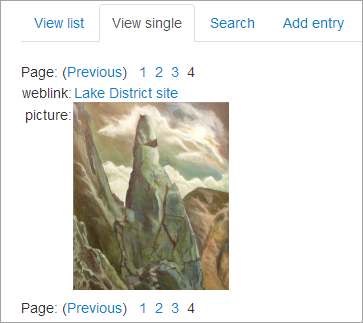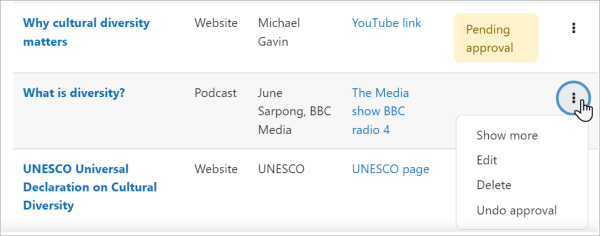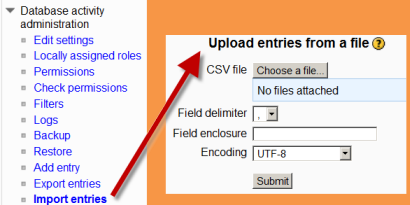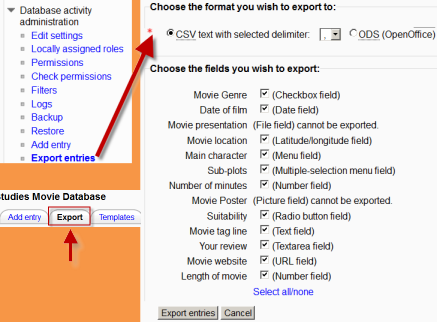Usando BasedeDatos
Nota: Pendiente de Traducir. ¡Anímese a traducir esta página!. ( y otras páginas pendientes)
Vistas
Ver lista
The list view shows multiple entries, possibly in a more abbreviated form to ensure all the information fits. You may use the controls at the bottom of the screen to search and sort the contents.
- View single: one item at a time
- View list : several items at a time (number is user defined)
- Add entry : add an item to the database
- Search : search the entries
Ver única
Alternatively, you may view only one entry at a time. This might allow you to view more detailed information than the list view.
Añadir comentario
If comments have been enabled, you may add a comment.
Valorar (calificar) entradas
Si las valoraciones han sido habilitadas, y hechas visibles, por el editor de la base de datos, Usted puede calificar otras entradas de la base de datos, y ver estas valoraciones (calificaciones).
Añadir una entrada
Vaya a la pestaña para "Añadir entrada" y llene el formato.
Eliminando entradas múltiples
Moodle 2.6
En la vista d elista, aparecerá una casilla junto a cada entrada. Selecione las entradas que quiera eliminar y elija el botón para 'Eliminar seleccionada'. De forma alterna, elija los botones de 'Seleccionar todo all' y 'Eliminar todo' para eliminar todas las entradas. Aparecerá un mensaje de advertencia para pedirle que verifique qué es lo que desea eliminar.
Enlazado automático entradas de BasedeDatos
If the Filtro de auto-enlace a BasedeDatos is enabled, any entries in a database will be automatically linked to where the concept words and/or phrases appear within the same course. This includes forum postings, internal resources, week summaries etc.
Note: If you do not want particular text to be linked (in a forum posting, say) then you should add <nolink> and </nolink> tags around the text. Alternatively the filter can be disabled for a particular activity.
Aprobar y quitar aprobación de entradas
¡Nueva característica
en Moodle 4.1 !
Si, durante la configuración de la Base de Datos se configura 'Aprobación necesaria' a ´Si´, entonces un profesor puede ver las entradas pendientes de ser aprobadas y elegir los tres puntos a la derecha para aprobarlas.
Si, durante la configuración de la BasedeDatos, se configuró 'Aprobación requerida' a 'Si' , entonces un profesor puede aprobar una entrada al hacer click en el ícono de la casilla de selección.
Una vez que una entrada ha sido aprobada, si es posible quitarle la aprobación al elegir el ícono para 'des-aprobar' (un círculo con una linea diagonal atravezada).
¡Nueva característica
en Moodle 3.0!
Las entradas que están esperando aprobación están resaltadas para el profesor y para el usuario que añadió la entrada.
Moodle 2.6
Importar varias entradas
You can import entries via a CSV file if you click the "Import entries" link under 'Database activity administration' in the Administration block of your course. CSV means Comma-Separated-Values and is a common format for text interchange.
The easiest way to determine the format of the text file is to manually add an entry to the database and then export it. The resulting export text file may then be edited and used for importing entries. Here's a sample of what a very simple file will look like.
The expected file format is a plain text file with a list of field names as the first record. The data then follows, one record per line.
The field delimiter defaults to a comma character and the field enclosure is not set by default (field enclosures are characters that surround each field in each record).
Records should be delimited by new lines (usually generated by pressing RETURN or ENTER in your text editor). Tabs can be specified using \t and newlines by \n.
Sample file:
name,height,weight Kai,180cm,80kg Kim,170cm,60kg Koo,190cm,20kg
Note: Certain field types may not be supported.
Do not put spaces after your commas or upload will fail!
After upload page import.php comes back blank if it failed. If successful you'll read a message like, "1 entries saved".
Exportar entradas
You can export entries either in CSV (comma separated values) or ODS (OpenOffice Calc) formats by clicking the tab at the top or by clicking the "Export entries" link under 'Database activity administration' in the Administration block in your course. (Both CSV and ODS formats can be opened with MS Excel.)
When using the CSV format, the user can select either the comma, semicolon, or tab to separate the fields. The selection of the proper character is important. If users select to use a comma to separate the fields and some of the fields contain data with commas then the number of columns is going to be misaligned and likely cause confusion.
Users can select which fields from the database they wish to have exported. By default, all fields are checked to be included. Choose the fields that you wish to have included in the export.
Once the export type and the fields to be exported have been selected, clicking on the Export entries pushbutton will generate the file. The user will usually have the option of either opening or saving the file.
For information on converting the date export (and import) format, see the discussion Standard Database Module - Dates.
Habilitar un canal RSS de entradas recientemente añadidas
To enable an RSS feed from a database activity, an administrator must first enable RSS feeds for database activities across the whole site as described in Configuraciones de canales RSS. A section called 'RSS' will then appear on the edit settings page of the database activity.
- Edit the database activity settings and set the number of entries in the RSS feed e.g. 5.
- Check that the RSS template includes the required fields.
- Log out and then access the database activity as a guest.
- Copy the 'RSS feed for this activity' link in the administration block.
The RSS feed may then be displayed in an Bloque de canales RSS remotos or elsewhere.
Exportar hacia un portafolio externo
If an external portafolio such as Mahara has been enabled by the administrator then users have the option to export individual entries to that portfolio. They will see at the bottom of a database entry an "export" icon to click on and select the portfolio to export to:
Ejemplos de BasesdeDatos
Moodle.org has two good examples of the database module in action:
- Moodle Buzz, a database of the titles, authors and web links to news articles mentioning Moodle
- Themes, a database with screenshots, download links and user comments about Moodle temas
Usos creativos
You could use the database module to:
- allow collaboration on building a collection of web links/books/journal references related to a particular subject
- display student created photos/posters/websites/poems for peer comment and review
- gather comments and votes on a shortlist of potential logos/mascot names/project ideas
- provide a student file storage area
- maintain a log of what was done in a face-to-face class each day, so that absent students can get caught up themselves. Example
Vea también
- Examples of databases in the School demo site (available for download)
- Módulo Dataform, which is a major enhancement of the Database module with improved browsing, editing, searching and other features.
- Módulo glosario, which performs a similar though more specialised, text-based role
- Using Moodle book Chapter 12: Databases
- Using Moodle Database activity module forum
- Tracking Students' Reading with the Moodle Database Module presentation
Using Moodle forum discussions:







